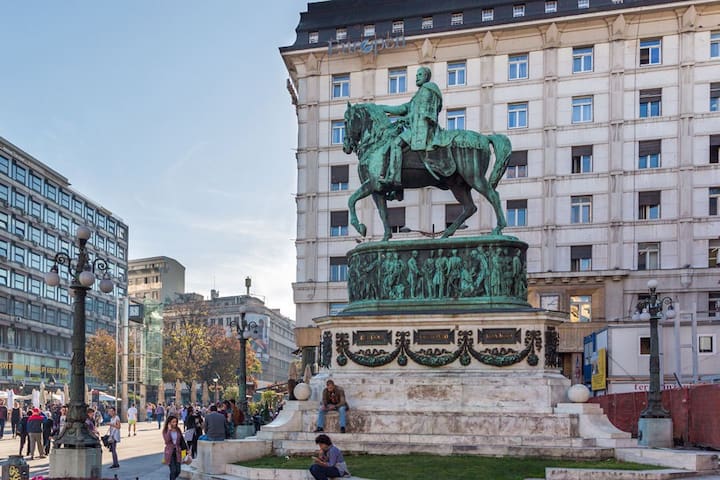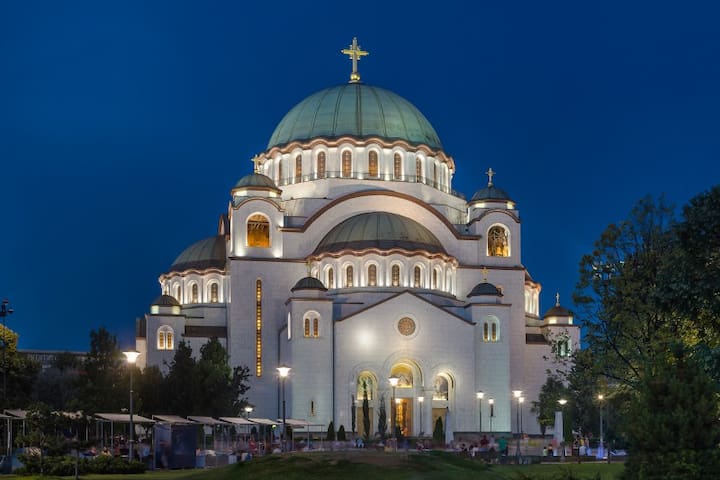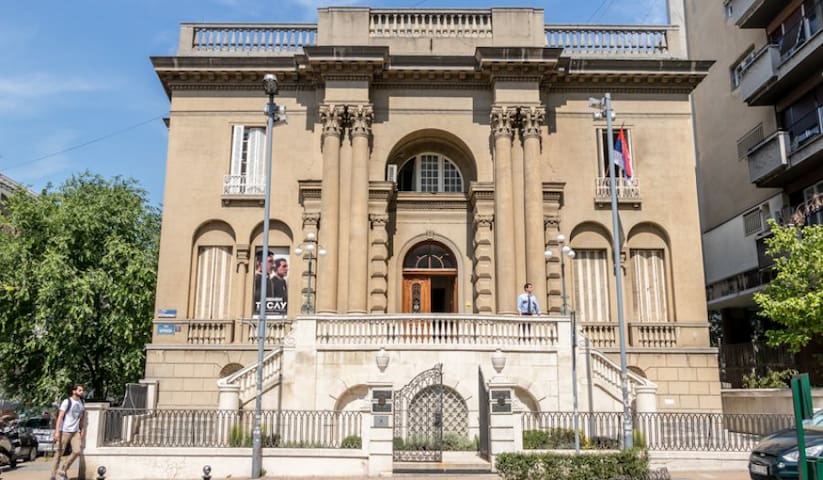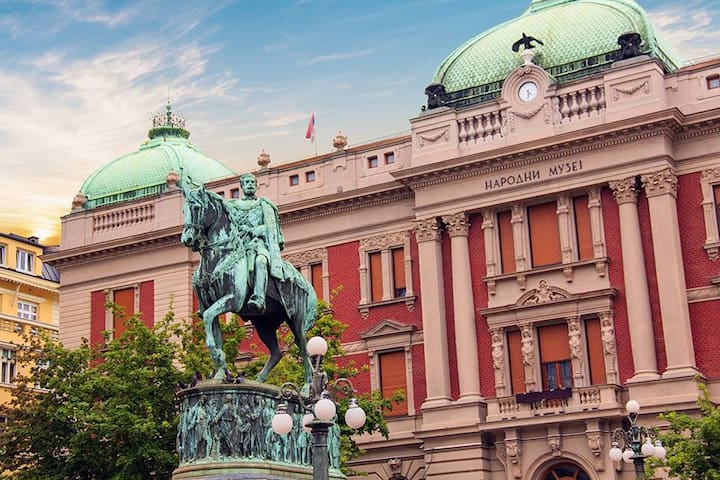Sightseeing
Tower Gardoš is one of the four Millennium Towers built by the Hungarian authorities on all four sides of the world, in the farthest cities of the kingdom, as part of the celebration of the thousandth anniversary of the settlement of Hungarians in Pannonia. The tower, 36 meters high, was built at the southernmost point of the kingdom, in Zemun, in the city of Belgrade, in 1896, at the elevation of Gardoš, on the foundations of the ancient Zemun fortress Taurunum from the 9th century, which stood as an important defensive point for centuries above the right bank of the Danube.
The Zemun Millennium Tower, from the period of the Hungarian kingdom, except in Hungary, is the only such preserved monument that has remained in the territory of other states.
23 lokalkjente anbefaler
Gardoš-tårnet, Zemun
31 SinđelićevaTower Gardoš is one of the four Millennium Towers built by the Hungarian authorities on all four sides of the world, in the farthest cities of the kingdom, as part of the celebration of the thousandth anniversary of the settlement of Hungarians in Pannonia. The tower, 36 meters high, was built at the southernmost point of the kingdom, in Zemun, in the city of Belgrade, in 1896, at the elevation of Gardoš, on the foundations of the ancient Zemun fortress Taurunum from the 9th century, which stood as an important defensive point for centuries above the right bank of the Danube.
The Zemun Millennium Tower, from the period of the Hungarian kingdom, except in Hungary, is the only such preserved monument that has remained in the territory of other states.
The Belgrade Fortress normally referred to as Kalemegdan is the largest attraction of the city free of charge with its gates open to public 24/ 7 all year round. It is situated in the heart of Belgrade and is adjacent to the city boroughs of Stari Grad, Dorcol and Savamala.
53 lokalkjente anbefaler
Beogradska tvrđava
The Belgrade Fortress normally referred to as Kalemegdan is the largest attraction of the city free of charge with its gates open to public 24/ 7 all year round. It is situated in the heart of Belgrade and is adjacent to the city boroughs of Stari Grad, Dorcol and Savamala.
If your Belgrade friends ask you to meet them in the city centre, more precisely at “the Horse”, then what they mean by that is just that – look for the Horse. But there is a surprise for you there, because there is no stable or stall in the city centre whatsoever. It is just the conspicuous statue of Prince Mihailo Obrenovic riding on horseback. This square is officially called Republic Square and it represents the very heart of the city and also a historical spot where for example many protests and riots have happened among other things.
227 lokalkjente anbefaler
Republikkplassen
3 Trg republikeIf your Belgrade friends ask you to meet them in the city centre, more precisely at “the Horse”, then what they mean by that is just that – look for the Horse. But there is a surprise for you there, because there is no stable or stall in the city centre whatsoever. It is just the conspicuous statue of Prince Mihailo Obrenovic riding on horseback. This square is officially called Republic Square and it represents the very heart of the city and also a historical spot where for example many protests and riots have happened among other things.
St. Sava Church is the largest Serbian Orthodox Church and the largest Orthodox place of worship in the Balkans. It was built on the very place where Sinan-Pasha is thought to have burned the remains of Rastko Nemanjic i.e. Saint Sava 1595 , founder of the Serbian Orthodox Church and the youngest son of the Serbian ruler Stefan Nemanja, a founder of Nemanjic dynasty. Even today, the interior of the St. Sava church has remained incomplete.
423 lokalkjente anbefaler
Tempelet til Saint Sava
2a KrušedolskaSt. Sava Church is the largest Serbian Orthodox Church and the largest Orthodox place of worship in the Balkans. It was built on the very place where Sinan-Pasha is thought to have burned the remains of Rastko Nemanjic i.e. Saint Sava 1595 , founder of the Serbian Orthodox Church and the youngest son of the Serbian ruler Stefan Nemanja, a founder of Nemanjic dynasty. Even today, the interior of the St. Sava church has remained incomplete.
The Nikola Tesla Museum is a science museum located in the central area of Belgrade ( Krunska 51 ). It is dedicated to honoring and displaying the life and work of Nikola Tesla. It holds more than 160,000 original documents, over 2,000 books and journals, over 1,200 historical technical exhibits, over 1,500 photographs and photo plates of original, technical objects, instruments and apparatus, and over 1,000 plans and drawings.
The Nikola Tesla Archive was inscribed on UNESCO's Memory of the World Programme Register in 2003 due to its critical role regarding history of electrification of the world and future technological advancements in this area.
513 lokalkjente anbefaler
Nikola Tesla-museet
51 KrunskaThe Nikola Tesla Museum is a science museum located in the central area of Belgrade ( Krunska 51 ). It is dedicated to honoring and displaying the life and work of Nikola Tesla. It holds more than 160,000 original documents, over 2,000 books and journals, over 1,200 historical technical exhibits, over 1,500 photographs and photo plates of original, technical objects, instruments and apparatus, and over 1,000 plans and drawings.
The Nikola Tesla Archive was inscribed on UNESCO's Memory of the World Programme Register in 2003 due to its critical role regarding history of electrification of the world and future technological advancements in this area.
The National Museum in Belgrade, a complex type museum, is the most significant, oldest and central museum of Serbia containing 34 archaeological, numismatic and historical collections at this moment, after 160 years of growth and development. The museum collections contain over 400,000 archaeological and historical-artistic items, key mementos for archaeology and the history of art, representing the development and civilisation changes within the region of contemporary Serbia and its nearest surroundings, as well as key artistic directions and styles, pinnacles of artistic achievement in the national and European art world from the medieval period to modern times. Some example of the unique exhibits are the sculptures from Lepenski vir (7th millennium B.C.), Vincian statues (6-5th millennium B.C.), a shed from Jabučje (1st century A.D.), Belgrade Camea (4th century), coins of King Radoslav (13th century), medieval icons and frescoes, a bowl from Vraćevšnica (17th century), paintings by Paja Jovanović (19th century) or Sava Šumanović (20th century). The National Museum also holds the Gospel of Miroslav (“Miroslavljevo Jevanđelje“) from the 12th century, the most valuable artefact of Serb culture, officially declared the most beautiful Cyrillic manuscript in the world and a cultural treasure placed, along with the archive of the Museum of Nikola Tesla, under the protection of the UNESCO program “Memories of the World”.
267 lokalkjente anbefaler
Belgrade City Museum
40b ResavskaThe National Museum in Belgrade, a complex type museum, is the most significant, oldest and central museum of Serbia containing 34 archaeological, numismatic and historical collections at this moment, after 160 years of growth and development. The museum collections contain over 400,000 archaeological and historical-artistic items, key mementos for archaeology and the history of art, representing the development and civilisation changes within the region of contemporary Serbia and its nearest surroundings, as well as key artistic directions and styles, pinnacles of artistic achievement in the national and European art world from the medieval period to modern times. Some example of the unique exhibits are the sculptures from Lepenski vir (7th millennium B.C.), Vincian statues (6-5th millennium B.C.), a shed from Jabučje (1st century A.D.), Belgrade Camea (4th century), coins of King Radoslav (13th century), medieval icons and frescoes, a bowl from Vraćevšnica (17th century), paintings by Paja Jovanović (19th century) or Sava Šumanović (20th century). The National Museum also holds the Gospel of Miroslav (“Miroslavljevo Jevanđelje“) from the 12th century, the most valuable artefact of Serb culture, officially declared the most beautiful Cyrillic manuscript in the world and a cultural treasure placed, along with the archive of the Museum of Nikola Tesla, under the protection of the UNESCO program “Memories of the World”.
Museum of Contemporary Art is an art museum located in Belgrade. It was founded in 1958 as the Modern Gallery. It was moved into the current building in the Ušće neighborhood of New Belgrade in 1965. The building is a masterpiece of architects Ivan Antić and Ivanka Raspopović, a short-lived but highly successful partnership, which also produced the 21 October Museum in Šumarice Memorial Park in Kragujevac. The collection contains more than 35,000 works of art.
The museum collects and displays art works produced since 1900 in Serbia and Yugoslavia. It also organizes international exhibitions of modern and contemporary art.
The museum was closed for renovation between 2007 and 2017. After several deadlines were pushed back, the museum was finally reopened for visitors on 20 October 2017.
179 lokalkjente anbefaler
Museum for samtidskunst
10 UšćeMuseum of Contemporary Art is an art museum located in Belgrade. It was founded in 1958 as the Modern Gallery. It was moved into the current building in the Ušće neighborhood of New Belgrade in 1965. The building is a masterpiece of architects Ivan Antić and Ivanka Raspopović, a short-lived but highly successful partnership, which also produced the 21 October Museum in Šumarice Memorial Park in Kragujevac. The collection contains more than 35,000 works of art.
The museum collects and displays art works produced since 1900 in Serbia and Yugoslavia. It also organizes international exhibitions of modern and contemporary art.
The museum was closed for renovation between 2007 and 2017. After several deadlines were pushed back, the museum was finally reopened for visitors on 20 October 2017.
Food scene
Beton Hala (Concrete Hall) is located in 2-4 “Karadjordjeva”Street, in Savamala, next to Belgrade Pier, at the Sava riverfront. The existing Concrete Hall in the first decade of the last century was extensively used for tourism, hospitality and commercial purposes. With the tourism picking up as of recent the citizens of Belgrade uncovered the great potential of former industrial buildings standing on the riverfront.
Today, Beton hala (The Concrete hall) represents a must visit “hotspot” in Belgrade and contains a few trendy restaurants
96 lokalkjente anbefaler
Beton Hala
2 KarađorđevaBeton Hala (Concrete Hall) is located in 2-4 “Karadjordjeva”Street, in Savamala, next to Belgrade Pier, at the Sava riverfront. The existing Concrete Hall in the first decade of the last century was extensively used for tourism, hospitality and commercial purposes. With the tourism picking up as of recent the citizens of Belgrade uncovered the great potential of former industrial buildings standing on the riverfront.
Today, Beton hala (The Concrete hall) represents a must visit “hotspot” in Belgrade and contains a few trendy restaurants
Skadarlija is a cobbled road which has lots of history paved deep in its pebbles beneath pedestrian’s feet, in an urban borough in the downtown area of Belgrade. It is considered the main bohemian borough of Belgrade, and is often referred to as ‘the Montmartre of Belgrade’ since in the past it was a popular focal point of Serbian and Yugoslav artists, writers and poets. Genuine traditional restaurants take pride in their guest lists of worldwide celebrities who have been their guests for decades now.
596 lokalkjente anbefaler
Skadarlija
24 SkadarskaSkadarlija is a cobbled road which has lots of history paved deep in its pebbles beneath pedestrian’s feet, in an urban borough in the downtown area of Belgrade. It is considered the main bohemian borough of Belgrade, and is often referred to as ‘the Montmartre of Belgrade’ since in the past it was a popular focal point of Serbian and Yugoslav artists, writers and poets. Genuine traditional restaurants take pride in their guest lists of worldwide celebrities who have been their guests for decades now.







